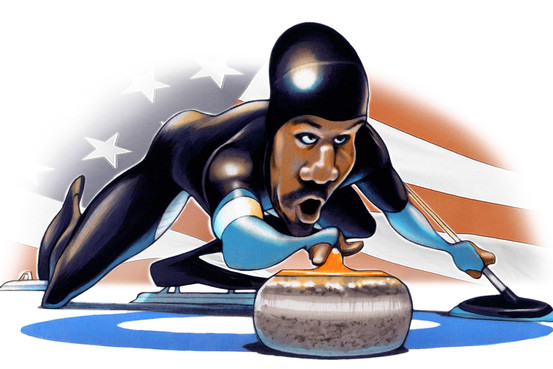Home -> News -> Media -> Sochi Olympics: Why Shani Davis Should Take Up Curling
Sochi Olympics: Why Shani Davis Should Take Up Curling

In one corner of the Olympic Park, the U.S. curling teams completed a dreadful showing at the Winter Games on Monday. The women finished last. The men finished second to last.
A few hundred yards away, inside the Adler Arena, the U.S. long-track speedskating teams haven't fared much better. Shani Davis and his teammates have failed to medal in eight races, igniting a team melodrama over the culpability of their Under Armour suits.
But if the improbable success of one nation in curling is any indication, there may be a way for the two beleaguered American programs to help each other out.
China has emerged as a curling power in large part by converting athletes from other ice sports into curlers. Its women's team, which won a bronze medal in Vancouver in 2010, includes three former speedskaters and one former figure skater. And the Chinese men, who defied expectations by advancing to the semifinals Monday, are led by two former speedskaters.
Could Davis be just what U.S. curling needs to improve its stature at the 2018 Games?
"He's certainly got the heart and the desire," said Rick Patzke, chief operating officer of USA Curling. "Athletes understand what it takes, so you're steps ahead already there. Someone who's in that mind-set certainly understands the dedication and commitment you need to put in."
The likelihood of Davis, a two-time speedskating gold medalist, trading in his skates for a rock and broom would seem to be low. But when asked if Davis would have any interest in giving curling a try, his spokesman, Nathaniel Mills, said: "I'm sure he'd love to someday, if he hasn't already."
If this sounds bonkers, first consider the state of American curling. These Olympics marked the second in a row in which both U.S. teams bombed. They each finished last in Vancouver. And with only around 16,000 curlers in the U.S., there is a shallow pool of talent to draw from.
Now consider the case of China, where curling barely exists. In a nation of more than 1.3 billion people, there are only around 330 curlers, according to the Chinese Curling Association. There are only four rinks in the entire country.
All of their Olympic curlers came out of the same sports academy in the northeastern city of Harbin, which produces most of China's Winter Olympic athletes. Many students wanted to become figure skaters or speedskaters. In the early 2000s, China convinced a small handful to become curlers.
"When curling first got into China, nobody knew about it," said Weidong Tan, an assistant coach on the women's team. "We just wanted to get athletes to try it. If they wanted to play, we would teach them to do that."
For nonelite skating prospects, curling offered another path to the Olympics. When asked if he could have made it here as a speedskater, Chinese curler Rui Lui laughed and said, "Probably not."
The link between speedskating and curling appears mostly coincidental. Curling is more of a finesse and strategy event. And the Chinese curlers have had more than a decade to learn it.
They are also well-funded by the Chinese government, which allows them to make curling their full-time jobs and spend much of the year competing and training in Canada. American curlers have no such luxury.
"Funding is always the issue for curling," U.S. captain John Shuster said.
But even a slumping Olympic speedskater fretting over his wardrobe might have enough athleticism to pick up the more physical aspects of curling, such as sweeping. Though shot strategy is crucial, it is dictated by just one player, known as the skip.
"Curling is the type of sport where a good athlete can pick it up pretty quickly," said Mike Harris, a former Canadian Olympic curler and longtime TV analyst. "It would be an interesting experiment, to take a couple of really good athletes and put them under two years of strict coaching and training and see how they do."
The U.S. has tried looking to other sports for curling prospects before. A couple of years ago, Patzke tried to form an alliance with The First Tee, an international youth golf program, to expose young golfers to curling. But talks didn't go far.
Former Olympic skeleton racer Zach Lund once told Patzke that he wanted to take up curling when his skeleton career was over. But Lund's last Olympic appearance came in 2010, and Patzke said, "We haven't touched base since."
For Davis, 31, curling may not hold much allure, either. But there would be some upside.
For one thing, it could allow him to extend his Olympic career, which appears to be finished. And if nothing else, taking up curling would allow Davis to put the Under Armour controversy squarely behind him.
American curlers wear Nike.
- .U.S. Treasury looks to hold more cash to deal with future crises
- .Yum, McDonald's in Shanghai food safety investigation
- .Yellen defends loose Fed policy, says job market still too weak
- .Carl Icahn says 'time to be cautious' on U.S. stocks
- .Samsung Electronics says second quarter profit likely down 24.5 percent; worst in two years
- .U.S. jobs data seen reinforcing strong growth outlook
- .Asia stocks up on buoyant Wall Street, oil near highs

